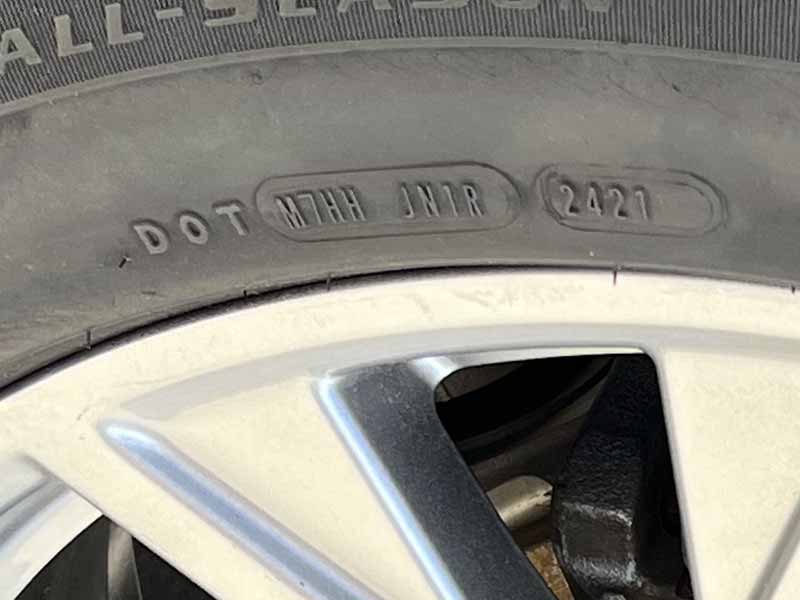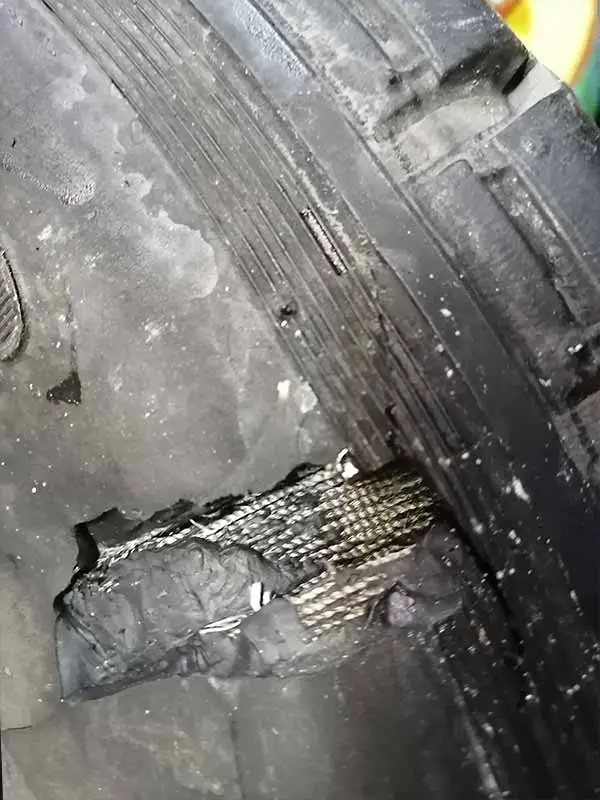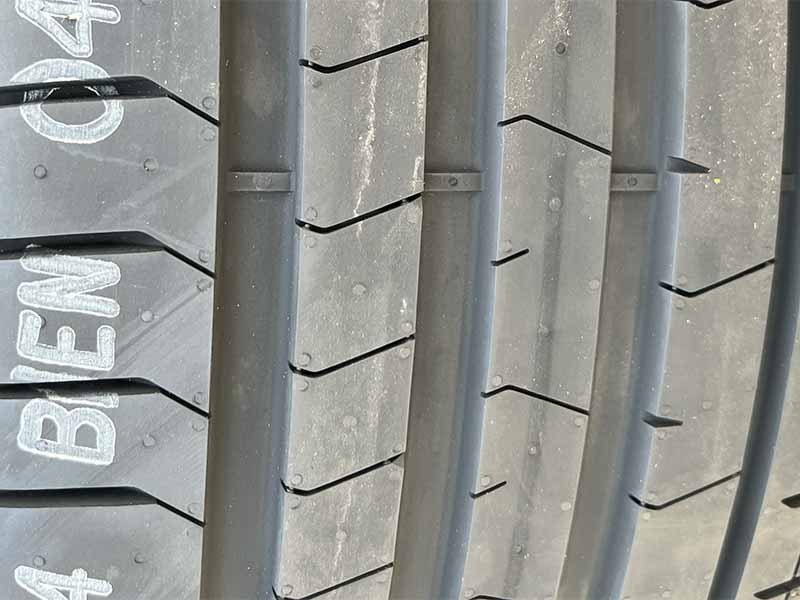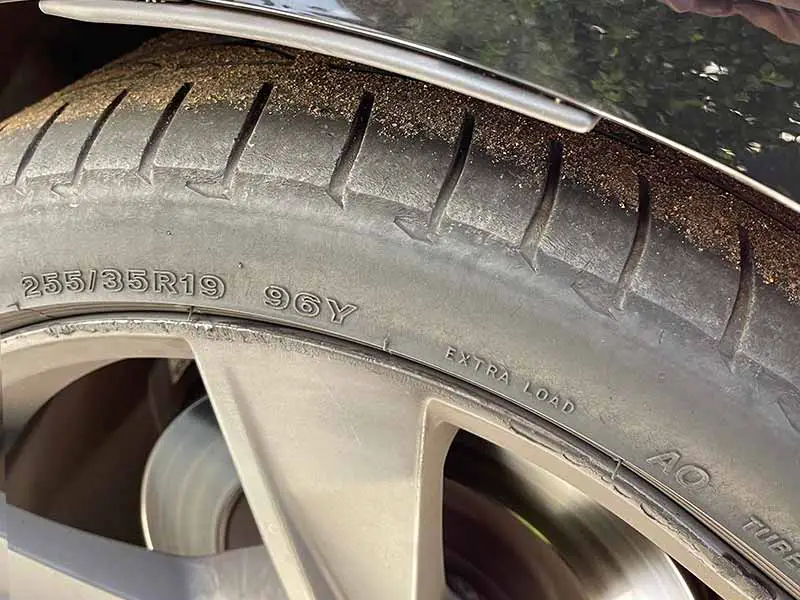There are many factors that affect how long tires last. New tires lose the ability to channel water away from under the contact patch of your tires slowly at first, but their performance decreases rapidly as they approach the minimum allowable tread level.
Replacing your tires earlier than 2/32″ of tread remaining is not required but is a wise move. The amount of remaining tread wear has much less grip in wet weather than tires with 4/32″ of tread or more.
Should You Replace Your Tires Early?
Tire replacement is suggested once your tires have only 4/32″ of tread depth remaining. This is because stopping distances on wet roads is greatly increased and the chance of hydroplaning is much worse at this level of tread wear.
Stopping distances greatly increase and the risk of hydroplaning at lower speeds becomes much more likely as your tires become more worn.
Let’s take a closer look.
3 Reasons To Replace Tires
Tread wear depth isn’t the only reason to replace your tires. There are three main reasons to keep in mind:
Tire Age
When your tires are over six years old, they begin to show advanced signs of dry rot. Dry rot is when the rubber compound of your tires becomes brittle and less flexible. This can lead to a catastrophic blowout and is extremely dangerous.
Ozone and ultraviolet radiation cause tires to dry rot over time. While it’s possible to store tires in a way that will slow this process, tires used on regularly driven cars and trucks should be replaced after six years of use.

Tire Damage
Tires can become damaged for many reasons and need to be replaced. Sidewall damage from potholes and curb strikes are some of the most common sources of tire damage. Other road hazards that cause punctures can also make it necessary to replace your tires.
Some punctures can be patched and can continue to be safely used. Larger punctures and those near or in the sidewall can’t be safely patched and will require replacing.

Tread Depth
Eventually, you will need to have your tires replaced when the tire tread depth has reached the minimum acceptable amount. As your tire tread depth decreases, it loses its ability to grip the road surface in wet weather.
Once the remaining tire’s tread reaches 2/32″, it will have a shockingly poor stopping grip in an emergency situation and the risk of hydroplaning will be greatly increased.

Tread On Tires – When To Replace
The legal minimum tread depth is 2/32″ and this is the point tire replacement is required. But just because it is required at this point doesn’t mean that you should wait for your tire wear to reach this point.
As your tires wear down, their ability to channel water out from under and away from the contact patch slowly reduces. New tires are extremely efficient at moving water away from underneath the tire tread due to the deep tread grooves and tread pattern.
As tires wear down, they slowly lose more and more traction on wet roads. A tire’s ability to grip in rainy conditions only decreases slightly at first, but as the tire wears it begins losing performance more quickly.
Should I Replace My Tires At 5/32″
5/32″ of tread depth is still considered a good amount of tread material and replacing tires at this point isn’t necessary. But it is near the end of the tire’s tread lifespan.
Once your tires wear to this point, you should be preparing for the purchase of a set of new tires.
Should I Replace My Tires At 4/32″
4/32″ of tread depth is the point that most tires should be considered ready to be replaced. The issue isn’t urgent at this point, but wet weather performance will be dramatically reduced from that of new tires and they are only 2/32″ away from being required to be replaced.

Should I Replace My Tires At 3/32″
3/32″ of tread depth is a very worn tire and only 1/32″ from requiring tire replacement. When tires wear down close to the minimum tread depth they lose traction performance more rapidly. The difference in performance between 4/32″ and 3/32″ is substantial.
While you are not required to replace your vehicle’s tires at this point, it is strongly encouraged.
Should I Replace My Tires At 2/32″
2/32″ is the minimum allowable tread depth and you must purchase new tires at this point. Waiting until your tire tread has reached the legal minimum is dangerous and not recommended.
Stopping distances in wet weather can be more than twice as long for some cars and trucks. Also, the chance of hydroplaning at even low speeds is very likely.

How To Know When To Replace Tires
Ultimately, if your tires are within an acceptable age and don’t have any damage that will require you to replace them early, the decision will be up to you as to what depth and loss of performance on wet roads are acceptable to you.
But to know when to replace your tires based on tread material you will need to know the depth of the remaining tread.
How To Read Tire Wear Bars
Most tires include a built-in wear indicator. The most common of these is called a wear bar. Wear bars are raised bumps at the bottom of the deepest tread grooves.
Wear bars are 2/32″ above the bottom of the tread groove. This means that when the top of your tread material has worn down to flush with the wear bar, you have reached the minimum allowable tread depth.

How To Measure Tread Depth With A Coin
A more helpful method of determining when tire replacement is necessary is by using a coin. The most common and convenient of which is to use a penny.
The penny test is a simple way to gauge the depth of your remaining tread by comparing the height of the tread material with where it lines up to Lincoln’s head.
Simply place a penny upside down into one of the main tread grooves.
- If Lincoln’s head is completely visible, you should replace your tires immediately.
- If the top of Lincoln’s head is partially hidden, but you can still see his forehead completely, you should consider replacing your tires very soon.
- If you can only see a portion of Lincoln’s forehead or not at all, you don’t need to consider replacing tires at the moment.
How To Measure Tread Depth With A Tire Tread Depth Gauge
The most accurate method for measuring the remaining depth of the tread material of your tires is by using a tread depth gauge.
There are different styles of gauges on the market. The most common are the plunger style, dial-style, and the digital-style.
Plunger Tread Depth Gauge
Plunger gauges are inexpensive and commonly used. They are reasonably accurate but can be difficult to read easily.
Dial Tread Depth Gauge
Dial gauges are my personal favorite type of gauge for measuring tread material. They are very accurate and very easy to read. They also are not terribly expensive and are always ready to use since they don’t rely on a battery.
Digital Tread Depth Gauge
Digital gauges seem like a more advanced and better method of determining the amount of tread remaining, but they have issues.
While they can be easy to read, they usually don’t display measurements in fractions which is the common unit of measure in the United States.
They also rely on a battery which will eventually fail and need to be replaced. The battery type often isn’t a common design and will usually require a trip to the store.
How To Make Tires Last Longer
New tires are expensive and no one enjoys wasting money on a set of four tires unless it’s required. Tires wear faster if they aren’t properly maintained. This includes many well-known tire maintenance practices, but we’ll cover them all and why each of these is important.
Driving Habits
An aggressive driving style will obviously cause accelerated tire wear. Hard braking and cornering puts stress on your tires and will wear them down much more quickly.
Dialing back your lead foot a notch can make a significant difference in how long your tires last.
Air Pressure
Proper tire pressure often gets overlooked. Most vehicle owners rely on their tire pressure monitoring system (TPMS) to alert them to a tire pressure problem. Unfortunately, this isn’t the best approach. TPMS is designed to alert when air pressures drop below 25% of the recommended pressure shown on the tire information sticker in the driver’s door jamb.
This leaves open the possibility that you’re riding around on tires well below the ideal inflation pressure. This will cause uneven tire wear and can even cause sidewall damage in some more extreme circumstances.
Tire Rotation
Tires should be rotated every 5,000 miles or so to ensure they are wearing evenly and to maintain the tire manufacturer’s mileage guarantee.
Neglecting to regularly rotate your tires will shorten tire life and cause you to need to replace your tires sooner than you would if they were properly rotated.
Wheel Alignment
One of the biggest sources of uneven tire wear patterns is wheel misalignment. Curb strikes and potholes can cause your alignment to fall out of spec over time.
Also, worn suspension components can allow your suspension to sag or shift which will prevent the alignment of your wheels from being able to align properly.
It’s recommended that you have your car or truck realigned every 10,000 miles.
Tire Balancing
As your tires wear down over time they can become unbalanced. Also, potholes and curb strikes can damage wheels or dislodge wheel weights and cause balance problems.
Having your tires and wheels rebalanced every 10,000 miles will help you get the most life out of them and prevent steering wheel vibrations and uneven wear due to a slightly bouncing tire.
Resources
Below are some links you may find helpful when learning about tires
Final Thoughts
Ultimately, you’re not required to replace the tires on your vehicle until the tire tread depth has worn down to 2/32″. But this small amount of tread left leaves very little margin for safety.
To ensure your tires can maintain traction on wet road surfaces, you should consider replacing your tires at 4/32″ or 3/32″ of remaining tread depth.
This will make a significant difference in stopping distances and help reduce the possibility of hydroplaning at lower speeds.
New tires are expensive, but if your current tires have visible damage, their age is more than six years, or the tread has only 2/32″ of depth left, you must purchase new tires for your safety and the safety of others on the road.
Good luck and happy motoring.










